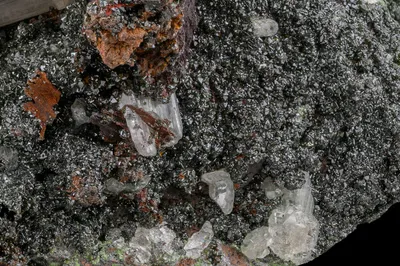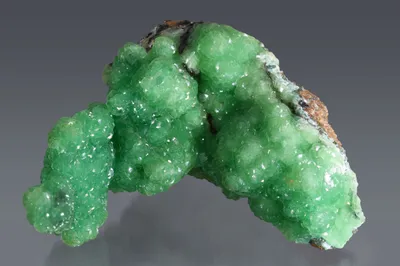
Image Credit: Malcolm Southwood
Mineral Species
Copper
Type Locality
No
Composition
Cu
Crystal System
Cubic
Status at Tsumeb
Confirmed
Abundance
Common
Distribution
First, second and third oxidation zones
Paragenesis
Supergene
Entry Number
Species; TSNB93
General Notes
Copper is by far the most abundant of the native elements reported from Tsumeb although Keller (1984) described it as "relatively rare". It occurs generally as dendritic or arborescent growths on (or in) dolomite or calcite. Spongy masses of hackly copper, often with jagged wires, twisted leaves or skeletal crystals are typical, while well-formed crystals are much less common.
Crystals are typically cubo-octahedral and exceptionally reach 50 mm in size (Gebhard 1999; Von Bezing et al. 2014). Twinning on {111} – the so-called "spinel-law" – is frequently observed. Less common habits include distorted tabular (sometimes paper-thin) crystals, exceptionally of pseudo-hexagonal outline (Von Bezing et al. 2007) and the elongated nail-like crystals noted by Gebhard (1999). The colour is sometimes copper-red but more typically tarnished to various shades of brown, grey or black; in some cases surface oxidation results in an attractive patina of malachite.
Native copper was recognised at Tsumeb from the very early days of mining (Maucher 1908a). Klein (1938), however, considered it rare between surface and 160 m deep (6 Level), but noted fine specimens between levels 8 and 12, with the best examples occurring at a depth of 220 m (8 Level). According to Klein’s handwritten catalogue (unpublished; Klein family archive) his specimens of native copper were collected from 7 Level (one specimen); 8 Level (six specimens, one of which is associated with smithsonite), 11 Level (3 specimens, two of which are associated with aragonite) and 12 Level (one specimen, with cuprite).
Bartelke (1976) noted a tendency for copper to be found in the deeper portions of the first and second oxidation zones. Consistent with this observation, Keller (1984) pointed out that copper (with cuprite) is a typical paragenesis for the transition zone between moderately oxidising and weakly reducing conditions.
Pinch and Wilson (1977) stated that copper was most common as dendritic aggregates and crystal masses in the second oxidation zone. Gebhard (1999) described single crystals to 30 mm, resembling nails, from 47 Level in the third oxidation zone and provided an image of this unusual habit (Gebhard 1999; page 303).
On a cautionary note, excellent examples of native copper have been found at the Onganja mines some 60 km NNE of Windhoek (Cairncross and Moir 1996) some of which have been mis-attributed to Tsumeb.
Associated Minerals
aragonite; berzelianite (?); calcite; cerussite; conichalcite; cuprite; devilline; dolomite; duftite; goethite; gypsum; malachite; mimetite; phosgenite; quartz; smithsonite; tenorite; witherite; wulfenite
Pseudomorphs
The following minerals are reported to form pseudomorphs after copper: cuprite (common); malachite (common).










